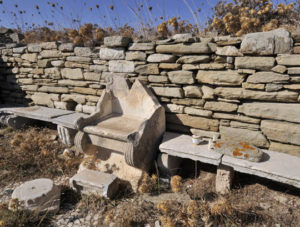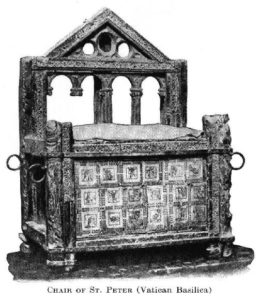[Greek] καθέδρα (kathedra), [Latin] sedere, [Latin] cathedra: chair, seat, bench, seat of authority (representing the synagogue chair which symbolized the origin and authority of their teaching; Mt. 21:12, Mk. 11:15, Mt.23:2
Background Information:
Greek Hellenism: This term means seat, chair, sitting and idling. Polybius’ Histories 1.21 states “They made the men sit on rower’s benches on dry land, in the same order as they would sit on the actual benches in actual vessels.” After the army had assembled, he had further injured himself in public estimation by his loitering at the Isthmus and the slowness with which the rest of the march had been conducted.
Old Testament: At some point in history, there was an actual chair or seat in which Moses sat. But more importantly, the Seat of Moses represents the authority to interpret the Jewish Law. In Ex. 10:13 Moses sat in judgment for the people. Moses used his authority to settle matters and disputes among the people. In Ex. 10:25 Moses appointed wise men as officers to help him in settling these issues. These associate judges decided ordinary cases. The more difficult cases were referred to Moses. A seat of authority (Moses’s Seat) is still remaining on the synagogue grounds at Delos, Greece. The synagogue is thought to have been built between 150 to 128 BC.
New Testament: Jesus entered the Temple and drove out all those engaged with buying and selling there. Jesus overturned the tables of the moneychangers and the seat of those who were selling doves. The scribes and Pharisees take their seat at the chair of Moses.
Scripture:
“The scribes and the Pharisees have taken their seat on the chair of Moses” Mt. 23:2
The chair of Moses mostly like represents Mosaic teaching authority.
Chair of St. Peter: Tradition holds that Senator Pudens, an early convert to the faith, gave this chair to St. Peter. This chair became the throne of the See. The Puden residence became a house church. Much of what remains is covered by the Church of St. Pudenziana. The chair of Peter was later excavated and now remains in the present Church of St. Peter’s.

Eusebius: Eusebius, a Greek historian of Christianity, makes reference to throne of James, the bishop of Rome. Eusebius states, “Now the throne of James, who was the first to receive from the savior and the apostles the episcopate of the Jerusalem church.” (320 AD).
Conclusion:
Cathedral, see, sedentery
From this comes the word cathedral. The bishop’s seat of authority is his kathedra. This is the chair (cathedral) were he holds down office. The Greek kata- means down. The bishop’s see is his ecclesiastical jurisdiction. See comes from the Latin sedes, meaning seat. It is also interesting to note that there exists a similar leadership structure with Moses and his staff, the chief Jewish priests and his staff, the bishop James and his fellow Apostles, and the Pope and the Cardinals.
